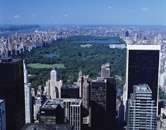Many Americans breathing cleaner air, report suggests

(HealthDay)—Although many Americans are now breathing cleaner air, others are living in cities that are more polluted than they were a decade ago, a new report shows.
"The long-term trend is positive and headed to much cleaner air," said report author Janice Nolen, assistant vice president of national policy and advocacy for the American Lung Association. "[However], there is an uptick in some areas that are a concern and some areas where the problem remains very, very serious."
The report, conducted by the American Lung Association, measured the levels of ozone and small particles in the air, known as soot, in almost 1,000 cities and counties in the United States between 2009 and 2011. About half of the 25 most polluted cities had improved since last year's report, and many of those cities were the cleanest they had been since the association began the research in 2000.
Unfortunately, the other half of the 25 most polluted cities was worse off. Even among the cities that improved, many were still near the top of the most-polluted list, including Los Angeles, which had the most ozone pollution, and Bakersfield, Calif., which had the highest level of particle pollution.
In total, there were 254 counties with unhealthy levels of ozone or particle pollution, and about 132 million people (42 percent of the U.S. population) live in these areas. The previous report had found that 127 million people (41 percent of the U.S. population) resided in areas with poor air quality.
In addition to the California cities, Houston, Dallas, Oklahoma City, Cincinnati, New York City and Washington, D.C., were among the metropolitan areas that had high levels of ozone. As for year-round levels of soot, many of the same cities in California topped the list, as well as Cincinnati and Canton in Ohio; Philadelphia and Allentown in Pennsylvania; Louisville, Ky.; St. Louis; and Fairbanks, Alaska.
One expert was not surprised by the findings.
"Being from California, I knew we had a few pretty bad areas, but this report really drives it home," said Irva Hertz-Picciotto, a professor of environmental and occupational health at the University of California, Davis.
The cleanest cities, which did not have a single day of unhealthy levels of ozone or particle pollution from 2009 to 2011, were Bismarck, N.D.; Rapid City, S.D.; and the Fort Meyers and Palm Beach areas of Florida.
A lot of it has to do with geography, Nolen said. Ozone, also known as smog, forms when gases from car exhaust, coal-fired power plants and other sources react with sunlight. In valley areas, like around Los Angeles, these gases get trapped, whereas they are dispersed quickly in elevated areas, she said.
The current report also listed more cities with unhealthy ozone levels than the last report, which is probably explained by hotter and sunnier weather, especially in the middle regions of the United States, Nolen said.
In addition to geography and climate, "a lot of transportation-related sources—cars and trucks and shipping ports—contribute to [the ozone] problem in the California area, and a lot of the most polluted cities in the eastern part of the country have coal-fired power plants," Nolen said.
To reduce the level of smog-causing vehicle emissions, the Environmental Protection Agency (EPA) proposed rules in March that would require less sulfur in gasoline and stricter vehicle emissions standards. Similar requirements went into effect in California in 2012.
Although health and environmental groups and the automobile industry support the proposal, oil companies oppose it, Nolen said. "We are encouraging people to support the EPA rule," she added.
Nolen recommended that people keep track of the air quality in their area through the AIRNow.gov website.
"If it is a high-alert day, drive less and don't burn wood or trash," she said.
Unfortunately, only about a third of counties in the United States have air-quality monitors, because they are expensive to install and collect, Nolen said. For the first time, however, this year's report has information on every county, using data from nearby cities and counties for areas that don't have their own monitors.
Both ozone and particle pollution can affect respiratory health, worsening breathing and increasing the risk of asthma attacks, respiratory infections and chronic obstructive pulmonary disease (COPD).
"People thought problems were limited to the lungs, but over the past 15 years quite a bit of work has shown things like cardiovascular effects," Hertz-Picciotto said. Studies have found links between high levels of ozone and soot and increased risk of heart attacks and stroke, as well as lower birth weights and increased risk of infant mortality.
Air quality can have the biggest effect on vulnerable groups of people, including young children, older adults and people with weak immune systems, Hertz-Picciotto said.
More information: You can find information about AIRNow and your local air quality and air pollution in general at the National Association of Clean Air Agencies.
Health News Copyright © 2013 HealthDay. All rights reserved.

















